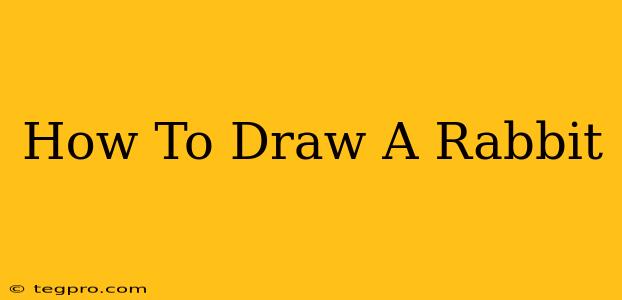Drawing a rabbit might seem daunting, but with a little practice and the right techniques, you can create adorable, realistic, or even cartoonish bunnies! This guide provides step-by-step instructions for different rabbit drawing styles, catering to all skill levels. Whether you're a complete beginner picking up a pencil for the first time or an experienced artist looking to refine your technique, you'll find something helpful here.
Getting Started: Essential Materials
Before we hop into the drawing process, let's gather our materials. You'll need:
- Paper: Choose a paper that's suitable for your chosen medium. Sketch paper works well for pencil sketches, while watercolor paper is ideal for watercolors.
- Pencils: A range of pencils (e.g., HB, 2B, 4B) will allow you to vary line weight and shading. A good eraser is crucial too!
- Optional Materials: Depending on your desired style, you might also want colored pencils, markers, crayons, or paints.
Method 1: Drawing a Simple Cartoon Rabbit
This method is perfect for beginners and kids. It focuses on creating a cute, simplified rabbit.
Step 1: The Head
Start by drawing a large circle for the rabbit's head.
Step 2: The Ears
Add two long, oval shapes on top of the head for the ears. Let them slightly overlap.
Step 3: The Body
Draw an oval slightly smaller than the head, overlapping the bottom of the head to form the body.
Step 4: The Legs
Add four small, oval shapes underneath the body for the legs.
Step 5: The Face
Draw two small circles for the eyes, a small triangle for the nose, and a curved line for the mouth. Add some whiskers!
Step 6: Details & Refinement
Erase any unnecessary guidelines and add details as desired. You could add a fluffy tail, shading, or even give your rabbit a unique personality.
Method 2: Drawing a More Realistic Rabbit
This method requires a bit more precision and observation but results in a more lifelike rabbit.
Step 1: Basic Shapes
Begin by sketching a circle for the head and an elongated oval for the body. Connect them with a curved line for the neck.
Step 2: Ears & Features
Draw the ears, paying attention to their shape and proportions. Lightly sketch in the eyes, nose, and mouth, using careful observation of reference images if needed.
Step 3: Legs & Feet
Sketch the front and hind legs, using slightly curved lines to depict their natural posture. Add small oval shapes for the feet. Remember that rabbit's hind legs are much longer and more powerful than their front legs.
Step 4: Fur & Detailing
Add details such as fur texture, shading, and highlights to give your rabbit depth and realism. Use lighter pencil strokes for the lighter areas and darker strokes for the shadows.
Step 5: Refinement & Final Touches
Erase unnecessary guidelines, refine the lines, and add any final details you wish.
Tips for Success
- Use References: Looking at pictures of rabbits will significantly improve your drawing. Pay attention to their proportions, posture, and unique features.
- Light and Shadow: Master the use of light and shadow to add depth and realism to your drawing.
- Practice Makes Perfect: Don't get discouraged if your first attempts aren't perfect. Keep practicing and experimenting with different techniques.
- Have Fun! The most important thing is to enjoy the process of creating your rabbit drawing.
Beyond the Basics: Exploring Different Styles
Once you've mastered the basics, you can experiment with different styles:
- Anthropomorphic Rabbits: Give your rabbit human-like characteristics and clothing.
- Stylized Rabbits: Create a unique and expressive rabbit with exaggerated features.
- Rabbit in a Specific Pose: Try drawing a rabbit running, hopping, or sitting.
Drawing a rabbit is a rewarding experience, providing a chance to express your creativity and develop your artistic skills. So grab your pencils, and let's get drawing!

